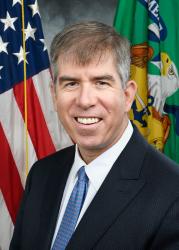Essential workers are being asked to carry a heavy burden for the rest of society during the COVID-19 pandemic. They are doing jobs that require them to be physically present at a place of work even as public health risks remain. They are disproportionately in low-income jobs while those able to work from home tend to have more education and be higher income.
Taking the necessary precautions to ensure worker safety is paramount. Yet, even if employers take every precaution to minimize employee exposure to COVID-19, essential workers still remain at substantial risk. As they travel to their jobs, potentially engage with customers, and work alongside others during the pandemic—it is clear that the nature of their work has changed, and it has become more dangerous than it was prior to the pandemic.
While some firms have provided temporary bonus payments—which are phasing out in many cases—the federal government has not acted to provide any targeted support for those who are still at work in order to keep the health, energy, food, and other industries going. In response, a range of proposals intended to compensate essential workers have been introduced in Congress.
In this analysis, we consider several policy options that could help boost workers’ wages. We also provide a categorization of which workers qualify as essential—those performing functions society urgently needs that must be done in person—and then detail their incomes and their demographic characteristics. This includes an estimate of the cost of providing bonuses to these workers over the next few months. For example: a program that provides $5 per hour to essential workers would cost $35 billion per month, and a scaled increase (that provides more to lower wage workers, but nothing to higher wage workers) would cost roughly $20 billion. Costs for options that include retroactive payments would depend on the number of months covered.
Who are “essential workers” and how much are they paid?
We begin with a list of occupations in which workers cannot do their jobs remotely and whose activities are essential to (figuratively or literally) “keep the lights on” even as other activities are temporarily limited during the pandemic. We use data for April 2020 as a period when many individuals were not working to get a better sense of the scale of essential workers across industries.
The list of occupations we consider (shown in figure 1) includes certain jobs within the following fields: transport, logistics, and delivery workers (25 percent of essential workers); health care providers and administrators (23 percent); food and agriculture workers (13 percent); retail workers (12 percent); maintenance and cleaning workers (10 percent); and those in the fields of protection, security, and justice (7 percent). Workers in other occupations like child care, energy/power, and death care make up the rest. (See the attached appendix table for the list of detailed occupation codes that we classify as “essential”; it embodies one view of how to categorize occupations as “essential” and is clearly not definitive. We use occupations as opposed to industries since industries by their nature include workers who can work from home or are furloughed.) It is important to note that, because not all workers in a given occupation are essential, we are likely overestimating the number of essential workers. Conversely, because we are using data from April, we are showing the maximum shut down of the U.S. economy. As the economy re-opens, there may be more workers in a number of these occupations—especially in restaurants—as can be seen by looking at the distributions for prior months.

By our calculation, in April 2020 workers in essential occupations constituted roughly 48 million workers, or about 42 percent of the U.S. employed workforce. As shown in table 1, they are more likely to be Black (16 percent) or Hispanic (21 percent) than the rest of the workforce (10 percent and 15 percent, respectively). They are also twice as likely to have a high school education or less compared to other workers.

Many essential workers earn relatively low wages. Over 4.3 million earn less than $10 an hour (see figure 2) and another 23.0 million earn between $10-20 an hour (12.9 million of which earn less than $15 an hour). All told, more than 57.1 percent of essential front-line workers earn less than $20 per hour; only 32.5 percent of other workers are paid less than $20 per hour. Despite their crucial role keeping the health system and economy functioning, many essential workers work for low wages and have not received any additional government support during this time.
 How to boost workers’ pay
How to boost workers’ pay
A number of proposals have been made to lift workers’ wages, ranging from a direct hourly increase in pay, to payroll tax cuts, to allowing newly re-employed workers to keep some of their unemployment insurance (see a recent Brookings discussion here). We do not evaluate the last option as it would set up large inequities between those who were working throughout—and hence did not receive any unemployment insurance—and those rehired to do the job, and it would be difficult to model without knowing how many people would return to work having received unemployment insurance.
In figure 3, we show how three hypothetical policies would affect the weekly earnings of full-time workers (i.e., 40 hours per week) at different earnings levels. The pay levels chosen are illustrative and could be dialed up or down:
- $5 per hour increase: The first policy would simply increase all workers’ wages by $5 an hour. Regardless of a worker’s pay level, this would provide an additional $200 a week.
- Scaled increase: The second would provide a worker with an hourly pay increase equal to half the difference between their current pay and $25 an hour. In this case, a $10 an hour worker would see a $300 weekly pay increase (raising their hourly wage to $17.50), a $20 an hour worker $100 (raising their wage to $22.50), and any worker earning over $25 an hour would see no increase.
- Payroll tax cut: The final policy is a payroll tax cut (effectively an 8.2 percent tax cut). Low wage workers would get very little (less than $40 a week) from such a policy since they have limited earnings, but a worker earning $30 an hour would get nearly $100 a week.

We choose these policies to highlight the different levers. Flat hourly increases have the advantage of benefiting all workers. Scaled increases allow a bigger bonus to lower wage workers, potentially offsetting any concerns of decreased work incentives stemming from more generous unemployment insurance. Payroll tax cuts provide little benefit to low wage essential workers and much larger benefits to higher wage workers. These policies could be continued for a fixed amount of time, until the public health emergency is over, until safety at particular firms is certified, or until unemployment insurance generosity phases down.
In table 2, we provide cost estimates for the different policies highlighted in figure 3. A flat $5 an hour increase in pay would cost just over $35 billion a month for essential workers or nearly $90 billion for all workers. In contrast, a scaled increase that would provide a substantial boost for the lowest wage workers costs roughly $20 billion for essential workers and $38 billion for all workers. A payroll tax cut, which does not help low wage workers much, would still cost roughly $40 billion a month as it would provide very large gains to higher income workers.

For a cost of just over $20 billion a month, low-wage front-line workers would see their weekly pay nearly double. It is important that such support be federally funded to avoid burdening firms or states, but for total costs far below the money already spent on fiscal policy response, low wage workers and the economy overall could benefit substantially.
As millions will struggle to find work even as the economy begins to recover, it is important that these economic incentives operate alongside generous unemployment insurance compensation—not as a replacement of it. While some observers have raised concerns that generous unemployment insurance compensation could be a disincentive to work for low wage workers (as the $600 pandemic unemployment compensation can make UI payments higher than low wage workers’ weekly incomes), a program to boost worker pay could help offset this effect and ultimately help workers and the economy. Therefore, these policies should not be seen as incentivizing people to return to work before it is safe, but rather as providing an economic reward for either low wage or front-line workers.
As the economy re-opens, significant concern remains that a “second wave” of a COVID-19 outbreak may force another shutdown of the economy in the coming months. Accordingly, it is important to think about how to support the low wage front-line workers who have borne the brunt of essential work during the pandemic. The challenges of being a front-line worker—from health risks to childcare challenges—are spread unequally across our society, with a disproportionate burden being carried by low-wage workers, Black and Hispanic Americans, and those with less education. As outlined in this analysis, a range of policy options exist to ensure they are receiving adequate pay during the pandemic, which would not only help economic outcomes for individual workers, but the broader economy as well.
The views expressed in this document are the authors’ alone and do not necessarily reflect those of the Federal Open Market Committee or anyone else in the Federal Reserve System.
The Brookings Institution is committed to quality, independence, and impact.
We are supported by a diverse array of funders. In line with our values and policies, each Brookings publication represents the sole views of its author(s).






Commentary
Examining Options to Boost Essential Worker Wages during the Pandemic
June 4, 2020